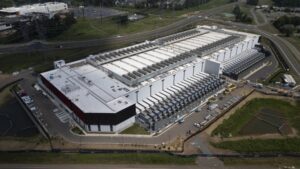Meta to Spend $600bn on US Data Centers by 2028
Meta claims it will spend $600 billion on digital infrastructure in the US over the next three years. Data centers are “crucial” to helping the company reach its goal of “building superintelligence for everyone” and “helping America maintain its technological edge,” the post said. Quite how Meta intends to fund this is unclear. The company posted annual revenue of $62.3 billion in 2024, and $600 billion figure is more than double the amount the firm has made during its 15 years as a public company. Meta has around 30 data center campuses in operation or development globally. Meta to spend $600bn on US data centers by 2028 – DCD



 An artificial intelligence data center that would use more electricity than every home in Wyoming combined before expanding to as much as five times that size will be built soon near Cheyenne, according to the city’s mayor. With cool weather — good for keeping computer temperatures down — and an abundance of inexpensive electricity from a top energy-producing state, Wyoming’s capital has become a hub of computing power. The city has been home to Microsoft data centers since 2012. An $800 million data center announced last year by Facebook parent company Meta Platforms is nearing completion. The latest data center, a joint effort between regional energy infrastructure company Tallgrass and AI data center developer Crusoe, would begin at 1.8 gigawatts of electricity and be scalable to 10 gigawatts. A gigawatt can power as many as 1 million homes. But that’s more homes than Wyoming has people. The least populated state, Wyoming, has about 590,000 people. But this proposed data center is so big, it would have its own dedicated energy from gas generation and renewable sources.
An artificial intelligence data center that would use more electricity than every home in Wyoming combined before expanding to as much as five times that size will be built soon near Cheyenne, according to the city’s mayor. With cool weather — good for keeping computer temperatures down — and an abundance of inexpensive electricity from a top energy-producing state, Wyoming’s capital has become a hub of computing power. The city has been home to Microsoft data centers since 2012. An $800 million data center announced last year by Facebook parent company Meta Platforms is nearing completion. The latest data center, a joint effort between regional energy infrastructure company Tallgrass and AI data center developer Crusoe, would begin at 1.8 gigawatts of electricity and be scalable to 10 gigawatts. A gigawatt can power as many as 1 million homes. But that’s more homes than Wyoming has people. The least populated state, Wyoming, has about 590,000 people. But this proposed data center is so big, it would have its own dedicated energy from gas generation and renewable sources.  Meta and other tech companies are scouring rural America for land, transmission lines and natural gas.
Meta and other tech companies are scouring rural America for land, transmission lines and natural gas.  Meta is expanding its smart glasses lineup with fresh offerings under both the Oakley and Ray-Ban brands—two labels united under Luxottica. Ray-Ban Meta smart glasses offer hands-free photo and video capture and voice-activated AI assistance. The new Oakley smart glasses designed with athletes and fitness enthusiasts in mind, feature a reconfigured camera mounted at the center of the frame to improve balance and tracking accuracy during high-intensity activities like cycling or running. Introducing Hypernova: The Premium Upgrade: Hypernova will feature a display on the bottom of the right lens, where information is directly projected into the wearer’s field of view, nudging the device closer to being a lightweight, wearable computer that might one day rival smartphones. While standard Ray-Ban Meta glasses are priced at around $299, Hypernova could fetch nearly $1,000 due to its advanced features.
Meta is expanding its smart glasses lineup with fresh offerings under both the Oakley and Ray-Ban brands—two labels united under Luxottica. Ray-Ban Meta smart glasses offer hands-free photo and video capture and voice-activated AI assistance. The new Oakley smart glasses designed with athletes and fitness enthusiasts in mind, feature a reconfigured camera mounted at the center of the frame to improve balance and tracking accuracy during high-intensity activities like cycling or running. Introducing Hypernova: The Premium Upgrade: Hypernova will feature a display on the bottom of the right lens, where information is directly projected into the wearer’s field of view, nudging the device closer to being a lightweight, wearable computer that might one day rival smartphones. While standard Ray-Ban Meta glasses are priced at around $299, Hypernova could fetch nearly $1,000 due to its advanced features.